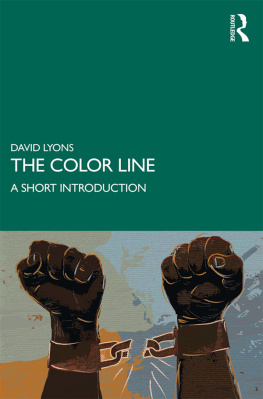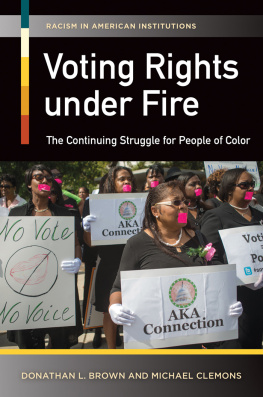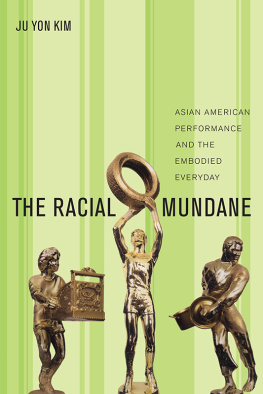THE COLOR LINE
The Color Line provides a concise history of the role of race and ethnicity in the US, from the early colonial period to the present, to reveal the public policies and private actions that have enabled racial subordination and the actors who have fought against it.
Focusing on Native Americans, African Americans, Asian Americans, and Latino Americans, it explores how racial subordination developed in the region, how it has been resisted and opposed, and how it has been sustained through independence, the abolition of slavery, the civil rights movement, and subsequent reforms. The text also considers the position of European immigrants to the US, interrogates relevant moral issues, and identifies persistent problems of public policy, arguing that all four centuries of racial subordination are relevant to understanding contemporary America and some of its most urgent issues.
This book will be of interest to students and scholars of American history, the history of race and ethnicity, and other related courses in the humanities and social sciences.
David Lyons is Professor Emeritus at Boston University, Massachusetts, USA. He previously taught at Cornell University in New York from 1964 to 1995. Focusing on moral and political theory, his previous books range from Forms and Limits of Utilitarianism (1965) to Confronting Injustice (2013).
By the same author
Forms and Limits of Utilitarianism
In the Interest of the Governed
Ethics and the Rule of Law
Moral Aspects of Legal Theory
Rights, Welfare, and Mills Moral Theory
Confronting Injustice
THE COLOR LINE
A Short Introduction
David Lyons
First published 2020
by Routledge
52 Vanderbilt Avenue, New York, NY 10017
and by Routledge
2 Park Square, Milton Park, Abingdon, Oxon, OX14 4RN
Routledge is an imprint of the Taylor & Francis Group, an informa business
2020 Taylor & Francis
The right of David Lyons to be identified as author of this work has been asserted by him in accordance with sections 77 and 78 of the Copyright, Designs and Patents Act 1988.
All rights reserved. No part of this book may be reprinted or reproduced or utilised in any form or by any electronic, mechanical, or other means, now known or hereafter invented, including photocopying and recording, or in any information storage or retrieval system, without permission in writing from the publishers.
Trademark notice: Product or corporate names may be trademarks or registered trademarks, and are used only for identification and explanation without intent to infringe.
Library of Congress Cataloging-in-Publication Data
A catalog record for this title has been requested
ISBN: 978-0-367-85651-9 (hbk)
ISBN: 978-0-367-81892-0 (pbk)
ISBN: 978-1-003-01417-1 (ebk)
Typeset in Bembo
by Newgen Publishing UK
To the memory of Elmer Sprague (19242019) teacher, mentor, and friend.
During all the years of their bondage, the slave master had a direct interest in discrediting the personality of those he held as property. Every man who had a thousand dollars so invested had a thousand reasons for painting the black man as fit only for slavery. Having made him the companion of horses and mules, he naturally sought to justify himself by assuming that the negro was not much better than a mule. The holders of twenty million dollars worth of property in human chattels procured the means of influencing press, pulpit, and politician, and through these instrumentalities they belittled our virtues and magnified our vices, and have made us odious in the eyes of the world.
Frederick Douglass, The Color Line, The North American Review, vol. 132 (1881), p. 573
It would be only fair to the reader to say frankly in advance that the attitude of any person toward this story will be distinctly influenced by his theories of the Negro race. If he believes that the Negro in America and in general is an average and ordinary human being, who under given environment develops like other human beings, then he will read this story and judge it by the facts adduced. If, however, he regards the Negro as a distinctly inferior creation, who can never successfully take part in modern civilization and whose emancipation and enfranchisement were gestures against nature, then he will need something more than the sort of facts that I have set down. But this latter person, I am not trying to convince. I am simply pointing out these two points of view, so obvious to Americans, and then without further ado, I am assuming the truth of the first. In fine, I am going to tell this story as though Negroes were ordinary human beings, realizing that this attitude will from the first seriously curtail my audience.
W.E. Burghardt Du Bois, Black Reconstruction in America: An Essay Toward a History of the Part Which Black Folk Played in the Attempt to Reconstruct Democracy in America, 18601880 [1934]. In The Oxford W.E.B. Du Bois, vol. 6, p. xliii. Copyright 2007 by Oxford University Press. Reproduced with permission of the publisher.
CONTENTS
I am grateful for research assistance to Jenna Fegreus, Stephanie Weigmann, David Aleksic, Matthew Bourque, Kate Cimini, Nam-Giao Do, Nir Eisikovits, Michael Fogleman, Eva Gach, Adam Goodstone, Buck Haddix, Nathan Hammonds, Michael Hinds, Travis Hubble, Charles Hunter, Lauren Ingoldsby, Chelsea Johnson, Peter Kawalek, Atif Khawaja, John Koss, Miriam Mack, Da Mao, Brendan McVey, Sindi Mncina, Ashkan Mojdehi, Kathleen OMalley, Jonny Schreiber, Alyssa Slater, Matthew Smith, Tagore Subramaniam, and Beth Walker. I am grateful for comments and suggestions on earlier drafts to Emily Lyons, Jeremy Lyons, Matthew Lyons, Sandra Lyons, Louis Hutchins, and anonymous readers for Routledge. My thanks to Eric Scarffe for the Index, to Fintan Power for copy-editing, to Zoe Forbes for guiding me through the publication process, and to Kelly Winter for managing the project.
Americans generally see themselves and are seen by fellow Americans as white, black, red, yellow, or brown. These assignments are not primarily descriptive. They place Americans within a set of racial categories, in which whiteness confers status and privilege. This color line, which is joined to the ideology and practice of white supremacy, is a founding pillar of American society.
When Europeans first came to America, they saw themselves as civilized Christians and as superior to the indigenous peoples they accosted, who they were prepared to subjugate and dispossess of their lands. As some Native Americans and enslaved Africans became Christians, however, religious affiliation could not continue as a reliable qualification for social privilege. Color, which Europeans also used to distinguish peoples, became a more useful tool of social division. Colonies like Virginia would restrict enslavement to non-whites, for example, and when the former colonies joined to become the United States of America, its Congress would soon declare that newcomers could become US citizens only if they were white.
The importance of the color line is suggested by the fact that, for most of American history, whiteness has been more valuable than citizenship. Someone who was classified as non-white could be (or could become) an American citizen, by treaty, birth, or legislation, but their citizenship did not carry equal rights. Residents of the northern half of Mexico, which the US annexed after the Mexican American War, became US citizens under the Treaty of Guadalupe Hidalgo (1848), for example, but these new Mexican American citizens were not regarded as white by the dominant American society and were subjected to systematic discrimination, segregation, lynching, and deportation. Following the Civil War (186165), the newly amended Constitution not only abolished slavery but also conferred US citizenship on anyone who was born in the US. But the legal subordination of African Americans was soon reestablished under the system called Jim Crow, which ensured that they could be systematically exploited, raped, and lynched with impunity. Although Puerto Ricans (in 1917) and Native Americans (in 1924) were made US citizens by federal legislation, they remained on the wrong side of the color line, still subject to systematic discrimination. During World War II, the US government interned more than a hundred thousand Japanese Americans in concentration camps, most of whom were US citizens. It did so without a trace of the due process that the Constitution guaranteed, although no federal agency had reason to believe that their imprisonment was required by military necessity. In other words, the color line renders persons of color






